50 Top Freelancing Statistics, Facts, And Trends For 2024

Are you looking for the latest freelancing statistics? We’ve got you covered.
As the gig economy continues to gather steam, more and more workers are ditching the traditional corporate 9-to-5 in favor of self-employment.
But just how many freelancers are out there? What kind of industries do they work in? And how much do these independent contractors earn, on average?
In this roundup of the top freelancing statistics, we’ll be answering all those questions and more. We’ll be looking at the state of the freelancing industry globally and then drilling down into specific countries and regions around the world.
Editor’s top picks – freelancing statistics
These are our most interesting statistics about freelancing:
- There is probably around 1.56 billion freelancing around the World. (Source: The World Bank2)
- The most popular freelancing skill is web design with 36%. (Source: PayPal)
- Africa holds around 10% of the world’s population of freelancers. (Source: Africa.com)
Global freelancing statistics
Let’s kick things off by taking a look at some global freelance statistics. These stats apply to the freelance workforce at large across the world.
1. Around 46.5% of the total global workforce are self-employed
This is according to estimates by the International Labour Organization.
If that’s higher than you’d expect, keep in mind that while in developed countries like the US, self-employment might only account for a small fraction of total employment, it’s a very different story in other countries with less developed economies. In developing countries, it’s not uncommon for the vast majority of people to be self-employed.
Interestingly, this rate of self-employed people as a percentage of total employment has been steadily declining for the last few decades. Prior to 2010, more than half of the global workforce was self-employed.
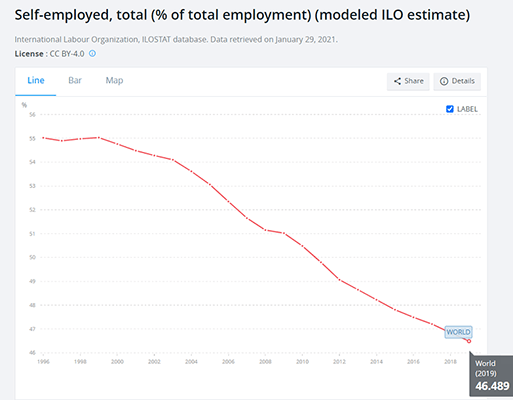
Source: The World Bank1
2. There are around 1.56 billion freelancers around the world (probably)
We struggled to find an accurate count of the number of freelancers around the world (other statistical roundups that offer estimations appear to be inaccurate).
However, given that the total global workforce stands at around 3.38 billion, and around 46.5% of that workforce are self-employed, we can conclude that there are around 1.56 billion freelancers globally.
Source: The World Bank2
3. Freelancers earn $19 per hour on average, globally
This is actually down from $21 per hour in 2014/15, likely due to the influx of new freelancers from emerging economies, where hourly rates tend to be lower.
However, it’s still very high compared to the average wages seen in traditional employment. For example, the average hourly wage for employees in the US (where wages are significantly higher than the global average) is just $11.26.
Source: Forbes
4. Gig economy platforms are responsible for around 1-3% of total employment
These are the platforms that connect freelancers to employers for temporary work (think Upwork, Freelancer.com, 99designs, etc). As this stat shows, their overall share of the wider employment market is still very modest.
Source: OECD iLibrary
5. Upwork is the leading global freelance platform
There’s a lot of competition in the freelance platform market. Upwork is the market leader, but only by a very small margin, with 9% of the market share. It’s closely followed by Toptal (8%) and Fiverr (5%).
Source: Seeking Alpha
6. Web design is the most popular freelancing skill
According to research by PayPal, 36% of businesses use freelancers for web design projects, making this the most in-demand freelancing skill. A further 31% use freelancers for programming, which ranked second. Other popular skills included graphic design and illustration (30%), web/mobile development (26%), and marketing and sales (24%).
Source: PayPal
7. 58% of freelancers report having worked with clients that fail to pay
One of the biggest problems freelancers face is dealing with clients that refuse to pay once the work is complete. According to a PayPal survey, more than half of all freelancers have experienced non-payment by clients in the past.
Source: PayPal
8. 32% of global freelancers say demand for their services has decreased during the pandemic
In March of 2020, when lockdowns were in full swing across the world, Payoneer’s survey of freelancers in over 100 countries found that 32% reported a huge decrease in demand caused by the economic downturn.
Those with North American and European clients were the worst hit and experienced a more severe impact than those with clients in Asia and Australia.
Source: Payoneer
9. …but 53% of freelancers expected that demand would boom post-pandemic
It’s not all doom and gloom. Freelancers remained optimistic that the decrease in demand caused by the economic impact of COVID-19 would only be temporary, and more than half expected to see a boom in demand post-pandemic. And it looks like they were right! By June, global freelance revenues were up 28%.
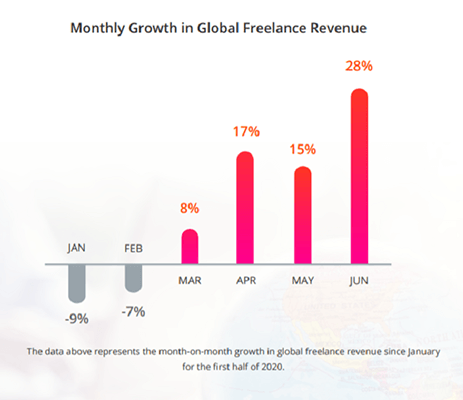
Source: Payoneer
US freelancing statistics
Next, let’s take a look at some US freelance statistics. These stats tell us more about the state of the freelance employment sector in America.
10. There are over 59 million people freelancing in the US
The US has one of the largest freelance workforces in the world. Over 59 million American citizens were freelancing in 2020, up from 53 million in 2013.
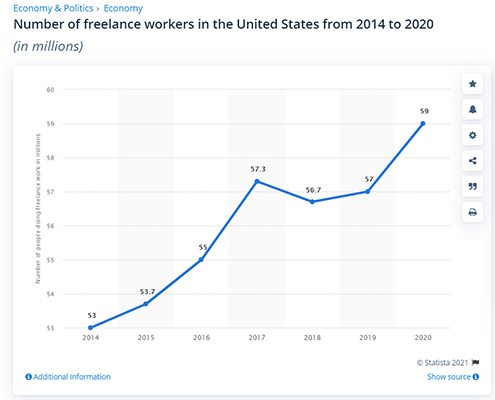
Source: Statista1
11. Freelancers make up around 37% of the US workforce
So we know that there are 59 million freelancers in the US. We also know that there are 161 million people in the wider US workforce. This tells us that freelancers make up over a third of the total US workforce, which is a significantly greater proportion than other countries with similar economies, like the UK.
Source: Statista2
12. It’s estimated that there 90.1 million people will be freelancing in the US by 2028
Despite the fact that there are already a huge number of freelancers in the US, experts predict that the freelance economy will continue to gain momentum over the next few years. By 2028, there will be 90.1 million people freelancing in the US. At this point, they’ll make up more than half of the total US workforce.

Source: Statista3
13. America’s gig economy grew the fastest of any country in 2019
Freelancer earnings in the US were up 78% year-on-year in 2019. The UK came next (up 59% YOY), and Brazil third (up 48% YOY).
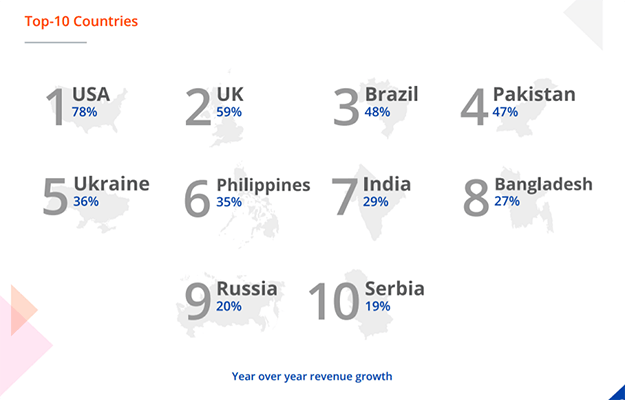
Source: Payoneer2
14. US-based freelancers were amongst the least hard hit by the pandemic
US freelancers saw a surge in demand even while those in full-time employment faced challenging times.
Employers who had to furlough or let go of full-time employers in order to downsize pivoted to filling the gaps with temporary freelancers instead. As a result, revenues were up 43% in June 2020.
Source: Payoneer
15. 58% of US professionals who began working remotely post-pandemic are considering freelancing
And I don’t blame them! Once you’ve had a taste of life outside of the office, it’s tough to go back.
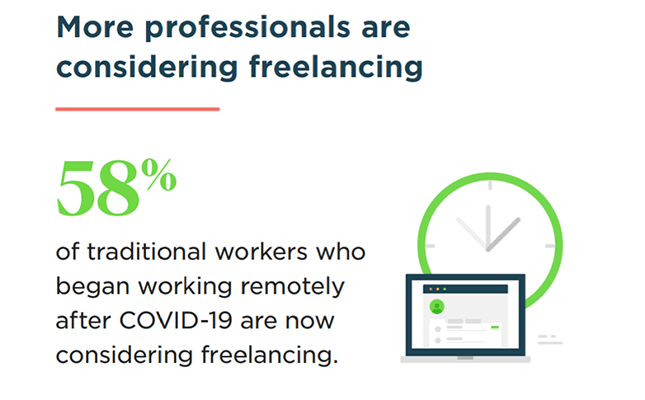
Source: Upwork
16. 36% of freelancers in the US freelance full time
Many people think that freelancing is only good as a supplementary, part-time income source, and consider it no replacement to full-time employment. However, as this stat shows, this isn’t necessarily the case. 36% of people freelancing in the US now do so full-time – that’s up by 8% since 2019.
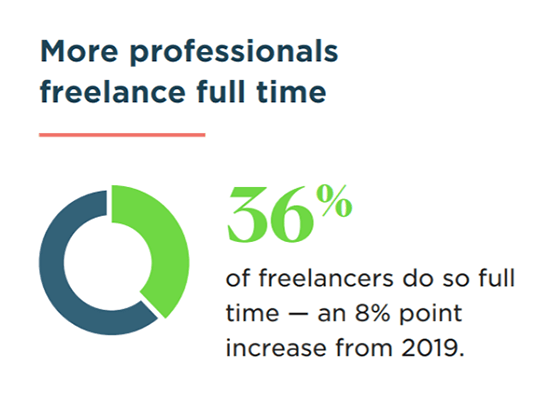
Source: Upwork
17. Freelancers in the US earned a whopping $1.2 trillion in 2020
This statistic shows just how huge the freelancing economy really is. It also represents an increase of 22% YOY.

Source: Upwork
18. 75% of US freelancers say they make more than they did in their previous salaried position
Freelancers tend to earn more than people in traditional employment on an hourly basis. It’s no surprise, then, that three-quarters of US freelancers say they earn more now than they did when they worked in a salaried position.
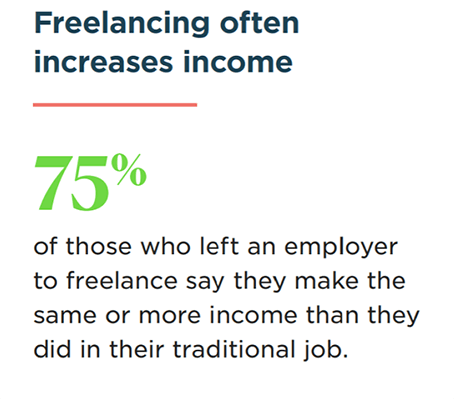
Source: Upwork
19. 48% of US freelancers are caregivers
One of the biggest draws of working freelance is that it gives you more control over your own working schedule. The flexibility this provides is ideal for people with dependents who need to fit in work alongside their family commitments.
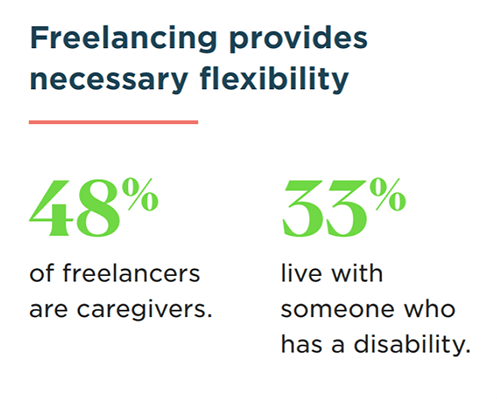
Source: Upwork
UK freelance statistics
Here are some freelance statistics that tell us more about the UK’s self-employed and freelance workforce.
20. There are around 4.35 million solo self-employed people in the UK
This works out at around 12% of the total UK workforce. The ‘self-employed’ in the UK include those running their own business, operating in a partnership, or working as a sole trader. The 4.35 million figure is down by 5% since 2019, according to research by ipse.

Source: ipse
21. There are around 2.2 million freelancers in the UK
Ipse uses a very narrow definition of the term ‘freelancer’. They use the term only to refer to the sub-sector of self-employed people that work in the top three most skilled occupations (based on SOC standards). As of 2020, there were 2.2 million freelancers that fit this definition, up by 1% from 2019.
Source: ipse
22. Freelancers contribute £162 billion to the UK economy
This speculative estimate might not be quite as impressive as the $1.2 trillion in the US, but it’s still pretty incredible. Studies have shown that freelancers in the UK play an especially important role in the economy as they drive innovation and provide greater efficiency, which boosts economic output.
Source: ipse
23. The vast majority of freelancers in the UK say it’s their main job
Freelancing in the UK isn’t a side-hustle – it’s a valid career choice. Unlike the US, in which only a little over a third of freelancers say they work full-time, the majority of freelancers in the UK say it’s their main job.
Source: ipse
24. 23% of all self-employed people in the UK work in ‘skilled trades occupations’
This includes skilled workers in sectors such as construction, agriculture, textiles, and food prep. Of these, construction and building trades is the biggest sector, accounting for 405,000 of the self-employed.
Source: ipse
25. Men account for 62% of the UK’s self-employed workforce…
While there’s clearly a large gender gap here, it’s getting smaller. The proportion of women working freelance compared to men has increased by 2 percentage points since last year.
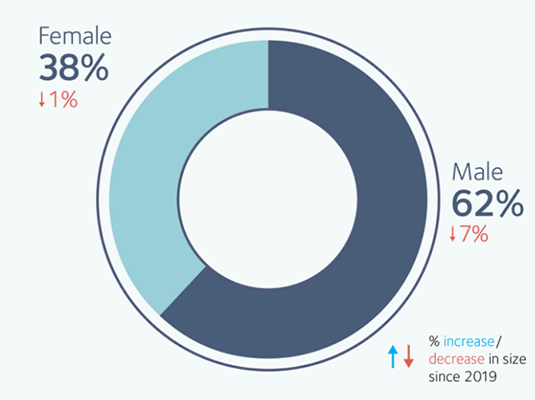
Source: ipse
26. … and 56% of the freelance workforce
Reminder: in the ipse study, ‘freelancers’ only refers to self-employed people working in the top three highly-skilled professions. The gender gap in these specific professions is much smaller: 56% are male while 44% are female.
Source: ipse
27. The largest self-employed age group in the UK is 50 to 59
People in this age group make up 25% of the total self-employed workforce. 40 to 49-year-olds come next, accounting for 23% of all self-employed individuals. It seems that younger people are less likely to work independently, as 16 to 29-year-olds make up only 11% of the UK’s self-employed population.

Source: ipse
28. 15% of UK self-employed only started freelancing last year
The UK freelance industry grew rapidly between 2019 and 2020. 15% of all self-employed people started working for themselves during that period, likely as a result of widespread furlough and downsizing caused by the pandemic.
Source: ipse
Europe freelance statistics
Wondering how many freelancers there are in Europe? Check out the European freelancing statistics below!
29. There are over 22 million self-employed workers in Europe
Interestingly, this tells us that self-employment isn’t as popular in Europe as it is in the US. Europe has less than half the number of self-employed workers in the US, despite the fact that it has a population more than 2x larger.
Source: Malt & BGC
30. Freelancers are the fastest-growing segment of the European labor market
Salaried positions reached their peak in 2000. Since then, independent work has been on the rise across the continent.
Source: Malt & BGC
31. Greece is the European country with the greatest proportion of self-employed people
Self-employed people make up around 30% of the total employment market of Greece, which makes it the country with the greatest proportion of self-employed workers. Italy ranked second at 22%.
Source: Eurostat
32. There are around 1.24 million freelancers in Germany
The total labor force of Germany stands at around 45 million, which means that freelancers only make up around 2.7% of the country’s workforce. For comparison, there are around 1 million freelancers in France and 753k in Spain.
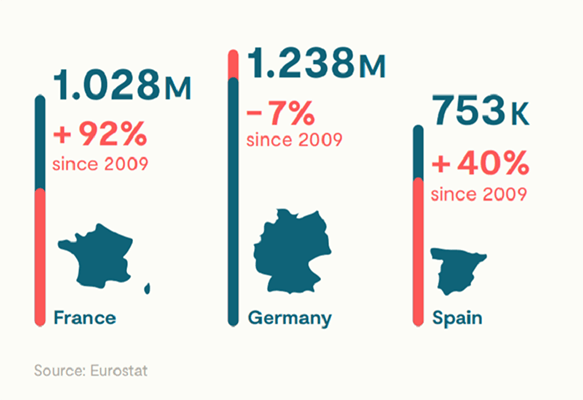
Source: Malt & BGC
33. The average age of freelancers in Europe is around 40
In Germany, the average freelancer is 45 years old. In France, the average age is 37; and in Spain, it’s 40.

Source: Malt & BGC
34. There are more male than female freelancers in Europe
As in the UK, there’s a clear gender divide in Europe’s freelance workforce. Men account for 65% of freelancers across the continent (around two-thirds).

Source: Malt & BGC
35. 77% of European freelancers have a bachelor’s degree
Freelancers in Europe tend to be highly educated. 77% hold a bachelor’s degree or above, and 54% hold a master’s degree. This is significantly higher than the general population, of which less than 40% are university graduates.

Source: Malt & BGC
36. Freelancers in Germany make more than other European countries
In the tech and data industry, German freelancers earn €735 per day, on average, compared to €492 in France and €230 in Spain. There’s a similar wage difference across other freelance industries (see the image above).
Source: Malt & BGC
37. 81% of European freelancers choose to become independent so they can manage their own schedules
More than four-fifths of those working freelance in Europe said they chose to become independent in order ‘to manage my time freely’, according to a recent survey.
The second most popular reason cited was ‘to make my own choices for my career’ (76%). Location independence is another big draw, with 73% of freelancers saying they became independent ‘to choose where I work’.
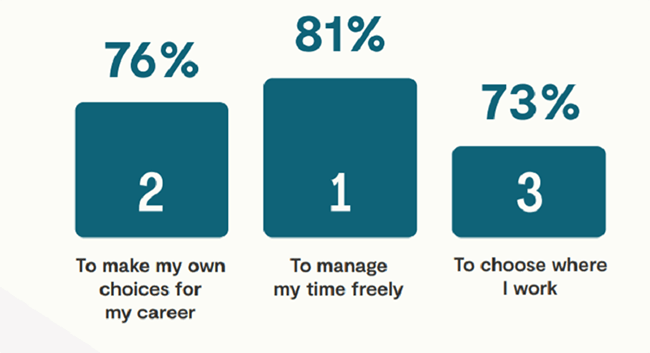
Source: Malt & BGC
38. European freelancers work around 43 hours per week, on average
There’s a common misconception that working freelance means working fewer hours per week. However, as this stat shows, that’s not necessarily the case – at least in Europe. Freelancers on the continent work a similar number of hours to people in salaried positions.
Source: Malt & BGC
Asia & Africa freelance statistics
Finally, let’s take a look at the state of the freelance economy in various Asian and African countries, and across the regions as a whole.
39. 84% of hiring managers in the Asia Pacific outsource to freelancers
Asia’s freelance economy is growing fast. According to a recent survey, 84% of hiring managers in the Asia Pacific have outsourced work to freelancers. The same survey found that companies that hire freelancers save 20%+ in labor costs.
Source: The ASEAN Post
40. Asia recorded the greatest regional growth in freelancer earnings in 2019
The US might be the country that topped the charts, but Asia’s freelance earnings grew the fastest of all regions. Freelance earnings were up by 138% across four Asian countries, including Pakistan, the Philippines, India, and Bangladesh.
Source: Payoneer2
41. The Philippines has the fastest-growing freelance economy globally
In 2020, freelancers in the Philippines experienced 208% YOY revenue growth. India came second at 160%, and Japan third at 87%.
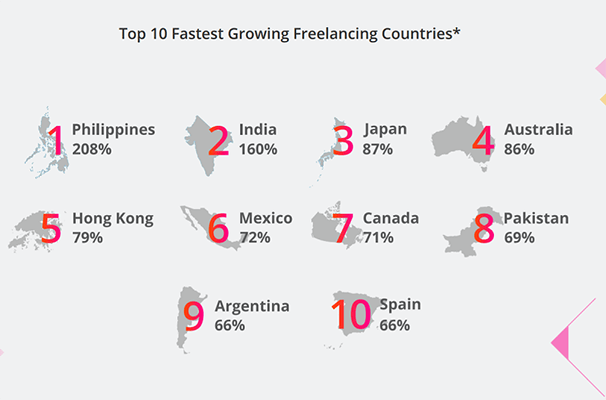
Source: Payoneer
42. There are 15 million freelancers in India
That might seem like a lot, but it’s only a tiny fraction of the country’s total population (1.38 billion).
Source: Payoneer
43. The number of new freelancers in India grew by 46% in the first quarter of 2020
More and more people in India seem to be seeing the potential benefits of freelancing, as the total number of new freelancers grew by a whopping 46% in Q1 2020.
Source: Payoneer
44. 55% of freelancers in India are aged 21-29
Unlike in the West, in which self-employment is more popular amongst older age groups, the majority of freelancers in India are under 30 years old.
Source: TOI
45. 46% of Indian freelancers look for work on online marketplaces
That includes platforms like Upwork, Freelancer.com, Fiverr, Guru, and Dribbble.
Source: TOI
46. There are an estimated 3.4 million freelancers in Japan
This makes up around 5% of the country’s 66-million strong workforce. Freelancing is less popular in Japan than in other countries in Asia due to the work culture. There’s a negative perception around freelancers – dubbed ‘freeters’ – with most people preferring the stability of traditional full-time employment in corporations. However, this may be changing.
Source: Japan Times
47. 60% of freelancers in Japan report issues in dealing with companies
Over half of all freelancers in Japan report experiencing ‘some sort of disadvantage’ with companies that hire them.
Source: Japan Times
48. Around 46.5% of the workforce of China are self-employed
This is according to modeled estimates by the ILO. Many parts of China are still economically developing, and it’s likely that the high proportion of self-employed workers is due to the lack of full-time employment opportunities in these regions.
Source: The World Bank1
49. Freelance revenue in Pakistan grew by 47% in June.
This huge surge in revenue was likely largely driven by the fact that local government authorities in the country shut down schools and other educational institutes as part of their COVID containment efforts.
As a result, demand for online education surged – and freelance online instructors took up the mantle. The government also launched an online training program specifically to enhance the population’s freelancing skills.
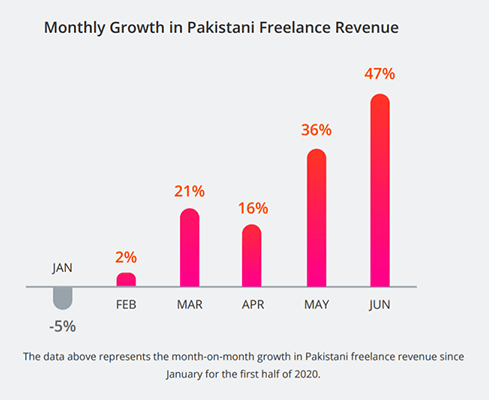
Source: Payoneer
50. Africa holds around 10% of the world’s population of freelancers
Freelancing has grown rapidly across Africa in recent years. Around 10% of the total global population of freelancers live in countries across the African continent, according to a study carried out by Payoneer and referenced on Africa.com.
Source: Africa.com
Freelancing statistics sources
Final thoughts
That concludes our roundup of the top freelancing statistics. Hopefully, this has helped shed some light on the state of the worldwide freelance economy, and how freelancing differs from country to country.
If, after reading this, you’re eager to join the growing freelance workforce, we’ve got plenty of blog posts that can help. You might want to start by checking out our roundup of the best freelance job websites.
And if you’d like to check out more interesting statistics, I’d recommend these posts:
